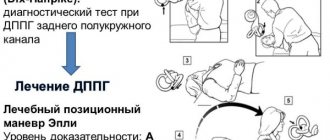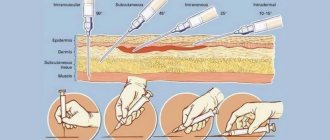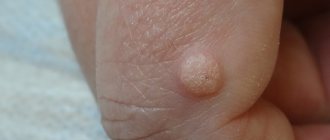To inject yourself into the thigh muscle tissue, you must have basic skills in using a syringe, needle and injection solution. It is recommended to resort to these therapeutic actions only in extreme cases, when there are no close people or medical workers nearby who can administer the drug intramuscularly.
Independent use of injection solutions requires compliance with safety rules, as well as a number of preparatory procedures that minimize the risk of complications.
Can I inject myself?
Injections into the muscle tissue of the outer thigh can be performed independently without the help of strangers. In order to administer the drug by injection to yourself, you should study in detail the provisions of the instructions that regulate the conduct of this kind of therapeutic measures.
Only if you have basic knowledge about the anatomical structure of the hip, the location of the lateral and deltoid muscles, and the possible risk of developing unwanted complications, can you begin independent treatment.
If you have the slightest doubt, a feeling of fear or an attack of panic that appears at the sight of a medical needle, it is recommended to refuse to inject the medication without the help of strangers.
How much do the injections cost?
| Rate | What is included | Price | |
| Tariff "1 injection" | The price includes sterile disposable materials Experienced medical staff *Price does not include drugs for administration | from 400 rubles | Call |
| Tariff "5 injections" | The price includes sterile disposable materials Experienced medical staff *Price does not include drugs for administration | from 1,750 rubles | Call |
| Tariff “10 injections” | The price includes sterile disposable materials Experienced medical staff *Price does not include drugs for administration | from 3,000 rubles | Call |
Correct needle insertion site
The insertion of a syringe needle for the purpose of a therapeutic procedure can be carried out into the muscles of the buttock or the outer side of the thigh. These are the main areas of the human body that are best suited for intramuscular injections. In some cases, shoulder tissue may be used.
Where to give injections in the thigh
If there is a need to inject into the outer side of the thigh, then it is necessary to use that part of the lower limb that is located at a distance of 20-25 cm below the hip joint. This area of the leg has sufficient muscle mass density, and the injection of a medicinal solution will be as convenient and safe as possible.
Itching and pain at the injection site
Sometimes after an injection, patients may experience unpleasant consequences: itching, redness or pain. There are many reasons for this: individual intolerance to the components of the drug, incorrect placement of the injection and improper care of the injection site, skin regeneration. As a rule, these sensations disappear 3-5 days after administration of the drug, but if the symptoms do not disappear, you should immediately consult a specialist.
Of course, it is better to find out in advance at the medical center how much the injection costs, but if this is not possible, then before administering the injection at home, you need to study all the rules in detail.
What is required for the procedure?
It is necessary to give injections in the thigh to yourself only after carrying out high-quality hygiene of the surface of the hands.
To carry out this therapeutic procedure, you will need to have the following items available:
- a sterile disposable syringe with a capacity of 2, 5, 10 ml, complete with a standard medical needle intended for intramuscular administration;
- a bottle or ampoule with a liquid medicinal solution that is indicated for use for therapeutic purposes;
- detailed instructions for using the drug to be injected into the outer thigh (before giving the injection, you must re-read the section on the dosage regimen);
- a pack of sterile medical cotton wool or pre-prepared napkins, tampons, which are used for antiseptic treatment of the skin surface of the thigh;
- ethyl alcohol 96% concentration, intended for disinfection of the tissue area into which the medicinal solution will be injected;
- a pair of medical gloves, the packaging of which is opened immediately at the time of therapeutic manipulations.
A medical needle for performing an intramuscular injection must have a length of at least 3 cm. This will minimize the appearance of unpleasant sensations after its introduction into the muscle tissue, and will also ensure the deepest possible application of the drug.
The components of the injection solution will act much faster, which will significantly increase the likelihood of a positive therapeutic effect.
Using a syringe with a needle that is too short can lead to the injection of an injection solution into the area of subcutaneous fatty tissue, which will subsequently cause local tissue inflammation, as well as the development of other undesirable complications.
Preparation for the procedure
Injections in the thigh should be given to yourself only after high-quality preparatory measures have been completed. This is a prerequisite for successful treatment without the help of medical personnel.
Preparation for self-administration of an injectable drug into the outer side of the thigh muscles involves the following steps:
- You need to take a bar of laundry soap and thoroughly wash your hands using warm water. Dry your skin with a clean and dry towel.
- Then you will need to open the package of medical gloves and put them on your hands, ensuring maximum sterility.
- The ampoule with the drug is shaken to ensure uniform mixing of all components, and then its surface is wiped with cotton wool, which has been previously moistened in 96% concentration of ethyl alcohol. These actions are aimed at disinfecting the bottle of medication.
- The tip of the ampoule with the injection solution must be carefully filed with an abrasive element, which should come with the drug, and then its glass top must be broken off.
- Open the package with a disposable sterile syringe.
- Place a medical needle on top of the syringe, remove the protective cap, and then insert it into the glass ampoule with the injection solution.
- Pull the plunger of the syringe so that a sufficient amount of liquid medication enters its cavity. In this case, it is necessary to remember the dosage regimen of the drug, avoiding the use of too large doses.
- Squeeze out the remaining air bubbles from the syringe that got into it during filling with the injection solution. These actions stop immediately as soon as the first drops of medication begin to flow from the needle hole.
At this stage, the specified organizational measures aimed at preparing for self-administration of the drug into the muscles of the outer thigh are considered completed.
To maintain maximum sterility, the injection is recommended to be given immediately. The disposable syringe is disposed of immediately after injecting the solution into the tissue of the lateral or deltoid muscle.
What reasons may prevent a person from carrying out self-injections into muscle tissue?
Never give injections that have not been prescribed to you by a medical professional. With such treatment you can greatly harm your body, especially if you do not know how to properly dilute the drugs and select the dosage.
When is the best time to get injections from doctors?
Any drug has its side effects and contraindications. Therefore, when the patient has never used this or that drug, it is necessary to first test for it. In any case, the first injection should be done under the supervision of a medical specialist. Only after this should a course of therapy be carried out.
Also, do not inject yourself if you have emotional problems. If you are afraid of the sight of blood or the syringe itself causes trembling in your hands, then refuse self-administered injections. It’s better to contact an experienced specialist and spare no time or money.
Basic safety rules when injecting yourself in the thigh
Injections in the thigh must be given to yourself with extreme caution so as not to damage large blood vessels and peripheral nerves.
A prerequisite for self-therapy with injection administration of drugs is compliance with the following safety rules:
- it is strictly forbidden to reuse a disposable syringe and needle, since such actions are fraught with infection of the tissues in the area of the injection;
- if it is necessary to carry out long-term drug therapy using intramuscular injections, it is necessary to alternate the left and right sides of the thighs in order to eliminate the factor of the formation of extensive hematomas;
- You should not inject into the same point of the thigh tissue, as this will lead to the appearance of symptoms of acute pain and will also cause the development of inflammatory processes;
- use imported syringes, as they are distinguished by sharper and thinner needles that do not cause severe pain in the area of their insertion, having minimal trauma to epithelial and muscle tissues;
- before intramuscular administration of the drug, it is always necessary to perform an antiseptic treatment of the skin surface to avoid complications;
- If minimal signs of an inflammatory process or the onset of subcutaneous bleeding or the formation of an extensive hematoma appear, you must immediately seek medical help.
It is important to remember that at the moment of self-injection into the outer thigh, the lower limb should be relaxed. For this purpose, the leg is placed on a flat surface, since excessive tension can provoke involuntary contraction of the muscle with damage to its tissue structure. A similar reaction occurs immediately at the moment of needle insertion.
Can all types of injections be given independently?
Many patients, when faced with the need to set up a course of injections, believe that injections at home are an easy process, but this is not so. If, for example, intramuscular injections do not pose a serious danger, and it is quite easy to do them even for yourself, then intravenous injections should be entrusted only to specialists. First of all, because they require a professional approach: it is not always easy to find a vein and it is very easy to leave bruises, and intravenous injections carry a much greater danger in terms of the likelihood of infection and infection.
To protect yourself, it is better to entrust any injection to a medical professional; besides, it is not necessary to go to the hospital; you can use the service of paramedics to administer injections at home.
For preventive purposes, it would be a good idea to take a massage course from qualified specialists at our clinic. Not only can it help cope with the consequences of poor conditions (bruises, hematomas, etc.), but it will also improve overall well-being.
How to give an injection correctly?
The most common methods of administering drug therapy in the form of injection solutions are injections into the deltoid, gluteal and lateralis muscles.
During a long course of treatment, the use of these areas of the body can be alternated to avoid the development of an inflammatory process in the tissues of the muscular system. At the same time, it is always necessary to follow the rules for the safe administration of medications that are available in the form of medicinal solutions.
Injection into the deltoid muscle
The deltoid muscle covers the entire front and side of the shoulder and is also distinguished by its dense tissue structure.
In order to inject yourself into this area of the body, you must adhere to the following algorithm of actions:
- Carry out all organizational activities dedicated to preparing for the injection of medication.
- Soak a piece of sterile cotton wool or a previously prepared swab in 96% concentration of ethyl alcohol.
- Perform an antiseptic treatment of the skin surface of the shoulder, wiping it thoroughly.
- Visually divide the deltoid muscle into 4 even squares.
- Bring the syringe with the exposed needle to the skin surface of the shoulder.
- Using a smooth and precise movement, insert the medical needle of the syringe into the upper right segment of the deltoid muscle to a depth of 2 cm.
- Slowly administer the injection solution contained in the cavity of the disposable syringe. Depending on the type of medication, a faster or slower injection of the medication may be required. In this case, you must carefully read the instructions for use of the drug.
- After administering the injection solution, it is necessary to slowly remove the syringe needle from the deltoid muscle tissue.
- Immediately cover the injection area with a clean piece of cotton wool, which has been previously moistened in 96% concentration of ethyl alcohol.
- Hold the cotton wool for the next 10 minutes, and then dispose of it in the prescribed manner. If signs of bleeding of the tissues located at the injection site appear, it is necessary to re-moisten the cotton wool in ethyl alcohol and hold it on the surface of the wound for another 10-15 minutes.
After injection of the drug into the deltoid muscle, mild discomfort may persist in the tissues of the shoulder. The appearance of more severe symptoms in the form of acute pain that does not stop for several days requires additional examination by a general practitioner or surgeon.
During the injection, the hand into which the drug is injected should be in the most relaxed state. This will reduce the severity of pain.
Injection into the lateralis muscle
It is not difficult to give injections in the thigh to yourself, but performing this type of procedure requires composure, a steady hand and maximum concentration. In order for the injection of the drug to be carried out technically correctly, the following instructions must be observed:
- Take a piece of sterile cotton wool, soak it in 96% concentration of ethyl alcohol, and then perform an antiseptic treatment on the outer surface of the thigh.
- Visually divide the lateralis muscle into 4 identical segments located 20 cm below the hip joint.
- Place the lower limb on a flat surface, completely relax its muscles, and place a cushion made of a towel or a piece of dense fabric under the knee joint. This will avoid reflex muscle contraction, which can occur immediately at the time of the injection.
- Insert a medical needle from a disposable syringe into the lower right segment of the lateral muscle, immersing it into the body to a depth of 2 cm.
- Slowly and without sudden movements, administer the injection solution until it is completely injected into the tissues of the lower limb.
- Smoothly remove the needle from the outer side of the thigh, and wipe the injection site with sterile cotton wool soaked in a 96% alcohol solution. Then you should press the cotton wool against the wound to avoid increased bleeding of the damaged area of the body.
- Hold the cotton wool for the next 10-15 minutes.
During the injection, it is necessary to keep the syringe as level as possible. The needle should not be directed at an acute angle, as in this case the injection will be too painful and may cause undesirable complications.
After injection of the drug, you should refrain from sudden movements for 20 minutes. The leg should be on a flat surface without being subject to physical stress.
How to give an injection in the buttock correctly
How to inject yourself?
How to give an injection to someone close to you is described above, but how to inject yourself? One of the biggest challenges faced is how to choose the right injection site.
How to give an injection in the buttock while standing? To determine the upper outer square of the buttock, it is better to practice in front of a mirror, and then proceed according to the instructions described above. The position of the body during the injection in this case can be either lying down or standing in front of a mirror in a half-turn.
How to properly give an injection in the buttock?
- Divide the buttock into 4 parts. First, divide the buttock in half from top to bottom, and then in half from side to side. If you are worried that you will do it wrong, draw a vertical and then a horizontal line on your buttock. Circle the injection site.
- The upper outer quarter is where the injection can be given to avoid damaging the sciatic nerve. You should feel a curved bone in this quarter. The injection will be in this quarter below the curved bone.
- Before giving the injection, complete all the preparatory steps described above.
- Treat the desired area with alcohol and tighten the skin tightly.
- Hold the syringe like a dart. Insert the needle at a right angle (90°) to the skin.
- Carefully insert the needle so as not to break it: not completely, 0.5–1 cm of the needle should remain outside.
- After administering the medicine, apply cotton wool soaked in alcohol to the injection site. As soon as you remove the needle, quickly press the injection site with cotton wool.
- Throw away used products and wash your hands.
Having learned how to properly inject in the buttock, it can still be scary to inject yourself in the buttock. In this case, you can always call a professional nurse to your home or go to the nearest clinic.
Possible complications
Technically incorrect execution of the injection, or failure to comply with the basic rules of preparation for intramuscular injection of an injection solution, can lead to the development of various kinds of negative consequences.
The table below lists the main types of complications that occur in patients who perform self-injections into the outer thigh or deltoid muscle of the body.
| Types of possible complications | Characteristics of the pathological process |
| Hematoma | The formation of a hematoma in the area of injection of the drug occurs due to the fact that when the needle penetrates the muscle tissue, damage to a large vessel occurs. The blood enters the subcutaneous tissue, coagulates and forms a dense lump, which is quite painful to the touch. The lack of treatment for this complication leads to more severe consequences in the form of the development of an acute purulent-inflammatory process. In this case, the help of a surgeon may be required to sanitation the damaged tissue. For faster resorption of the resulting hematoma, regular treatment of the painful area with ointments and gels with angioprotective properties is recommended. |
| Isolation of infiltrate | One of the most common complications that arise after self-performing intramuscular injections is the release of infiltrate, which accumulates in the subcutaneous space and soft tissues. The sacral fluid enters the surface of the epidermis and is distinguished by a rich reddish tint. A similar complication develops after a medicinal solution is injected into the same place for several days in a row without making a sufficient indentation. The release of infiltrate indicates the initial stage of the inflammatory process, which tends to progress. To eliminate this complication, a warm compress is applied to the surface of the outer thigh or deltoid muscle, and a mesh of medicinal iodine solution is also applied. |
| Broken medical needle base | A complication in the form of a broken syringe needle may occur due to a violation of the technical rules for performing the injection. For example, if at the time of the injection the muscle tissue of a person’s lower limb was in a state of tension, or the needle was inserted into the body at an acute angle until the very beginning of its cannula. If such an unusual situation arises, it is necessary to remove the needle fragment using medical tweezers. If the metal part goes too deep into the tissue, then you should use the services of a surgeon. |
| Purulent inflammation | This complication occurs due to the fact that a person who independently performs injections on the outer side of the thigh does not follow the rules of antiseptic skin treatment. During the injection of the drug, infection of soft tissues occurs, which are subsequently affected by bacterial, viral or fungal microorganisms. Purulent inflammation of the injection site is accompanied by the formation of a dense abscess, an increase in general and local body temperature, and the beginning of the process of tissue necrosis. |
| Lump formation | The appearance of lumps in the area where the drug was injected without signs of acute pain is possible if a person independently administered injections, but did not follow safety rules. In conditions of prolonged hypothermia of the body, the solution hardens in the muscle tissues, and their natural trophism is disrupted. Ultimately, compactions form in the lateral or deltoid muscle, the elimination of which requires the use of drugs with absorbable properties or the method of their surgical removal is used. |
| Nerve damage | In order to prevent this complication from occurring, it is necessary to inject directly into the muscle where there is no passage of peripheral nerves. A person who does not have knowledge about the anatomical structure of his body may mistakenly insert a syringe needle next to a nerve. As a result of performing these actions, an attack of acute pain occurs, a reflex contraction of the muscle tissue of the limb occurs, and their edematous state develops. The pain syndrome may persist for a long period of time. |
The occurrence of the above complications can be avoided if injections are performed technically correctly and safety rules are followed.
Why does my leg hurt after an injection and what should I do?
Pain that persists for more than 1 hour after intramuscular injection may be caused by injury to a blood vessel or peripheral nerve. In this case, you need to seek medical help from a surgeon.
To give yourself an intramuscular injection into the outer thigh or deltoid muscle of the shoulder girdle, you must have basic knowledge of the anatomical structure of the human body. In this case, you should follow the rules of the instructions for inserting a medical syringe needle into soft tissues, and carefully carry out all stages of preparation for this therapeutic procedure.
Failure to comply with antiseptic body treatment measures, reuse of disposable syringes, prolonged hypothermia of the body can provoke the development of complications in the form of local inflammation, the formation of a purulent abscess, and multiple lumps.
Does it hurt to give yourself injections?
The sensations during the injection largely depend on the individual sensitivity threshold and the characteristics of the medicine. Some drugs (such as Heparin and Ceftriaxone) cause discomfort even when administered by experienced healthcare professionals. Doctors usually warn that the solution stings during administration and recommend diluting them with an anesthetic solution of Lidocaine (if this does not contradict the principles of treatment). You cannot adjust, reduce or increase the dose on your own, otherwise the effect of treatment will be zero or the opposite.
Minor bruises and hemorrhages are considered not a complication, but a side effect of the injections. They occur due to the fact that the needle enters a blood vessel, usually go away on their own and are not accompanied by unpleasant sensations.










